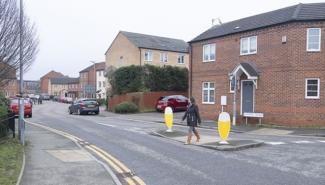Depending on the environment, there are different types of crossings installed to help pedestrians cross the road:
Pedestrian refuge point

A pedestrian refuge island is a raised section of pavement between two lanes of traffic moving in opposite directions.
It is sometimes referred to as a crossing island, pedestrian island or refuge island.
Pedestrian refuge islands normally have yellow and white plastic bollards with a blue arrow to remind motorists to keep left.
Kerbs are dropped at both sides of the road, usually with tactile paving where the pavement slopes towards the road.
Pedestrian refuge islands allow pedestrians to stop in the centre of the road, so they can split the crossing into two stages for each direction of traffic.
Pedestrian refuge islands are designed as a safe place to cross the road by providing some protection from traffic in the centre of the road.
They can also make the road look narrower and result in a degree of speed reduction.
The sites where refuges can be used are limited as they rely heavily on good forward visibility from approaching drivers and shouldn’t be placed across or very near to private drives or side roads.
Also, if the road is narrow and there is no opportunity to widen the road then there could be insufficient space to site a refuge.
Drivers are not required to stop at a pedestrian refuge island, even if there is a pedestrian on the refuge waiting to cross.
Useful links
Zebra crossing

This a formal pedestrian crossing point which is highlighted by black and white painted stripes, zig zags and flashing yellow lights.
Zebra crossings help pedestrians cross safely from one side of the road to the other.
They can be used as an alternative to pelican crossings where pedestrian crossing movements aren’t as frequent and where traffic is generally travelling at a lower speed.
There needs to be recognised pedestrian crossing demand when considering this type of crossing.
Drivers and riders should give way to pedestrians who are on the crossing and those waiting to cross.
However, drivers and riders are not required to stop until the pedestrian has actually moved on to the crossing.
Safe use of this crossing relies on the judgement of the pedestrian on when to enter the road at a safe point.
Pelican crossing

Pelican crossings use traffic lights to stop vehicles, allowing pedestrians to cross.
Pelican crossings give a clear signal to motorists that they need to stop (red light) and to pedestrians (green man) when they should cross.
These signalised pedestrian crossing points are used where pedestrian road crossing movements are particularly high and the road in question experiences excessive speed.
Pelican crossings must be installed where the traffic light signals are visible to approaching vehicles.
Toucan crossing

Toucan crossings are designed to be wide enough for both pedestrians and cyclists to safely cross a road side by side.
They allow cyclists to cross without dismounting which they would have to do at other crossings.
Toucan crossings give a clear signal to motorists they need to stop (red light) and to pedestrians and cyclists (green man and bicycle) when they should cross.
Parallel crossing

The parallel crossing looks similar to a zebra crossing but also includes a cycling crossing area, parallel to the zebra crossing area which is marked by broken white lines.
Parallel crossings enable cyclists to cross a road safely and with the same level of priority as a zebra crossing gives a pedestrian.
Pegasus crossing

A Pegasus crossing is a type of crossing with special consideration for horse riders, with the control panel being positioned at a height of two metres so that horse riders don’t have to dismount in order to operate the crossing.
These signalised horse crossing points are used where horse road crossing movements are particularly high and the road in question experiences excessive speed. Pegasus crossings give a clear signal to motorists they need to stop (red light) and to pedestrians (green horse and rider) when they should cross.
Tactile paving

Tactile paving bears a distinctive raised surface profile to be detected by both sighted and visually impaired pedestrians and help them recognise potential hazards and changes to the road.
The colour and texture of the surface further helps the pedestrian’s awareness of the situation.
They're used in conjunction with dropped kerbs at points in the carriageway where it is considered safer for pedestrians to cross.
Dropped kerb (Pedestrian crossing point)

Pedestrian crossing points are where the kerb has been lowered to the same level as the road, forming a crossing point. Dropped kerbs encourage pedestrians to cross the road at safer locations. They are also helpful for wheelchair users to easily move between pavements.
It is an offence to park across this feature. The council can issue Penalty Charge Notices (PCNs) to drivers who park on the carriageway next to a pedestrian crossing point.